Creating an effective lesson plan is crucial for teachers to ensure a structured and successful learning experience. In today's digital age, online tools have made it easier than ever to craft lesson plans that cater to different subjects and age groups. In this article, we will explore eight practical examples of lesson plans for various educational settings and introduce an innovative AI generator tool that can assist in the creation of these plans.
What is the Lesson Plan Format
Creating an effective lesson plan involves following a structured format to ensure comprehensive coverage of your teaching goals. While formats can vary slightly depending on the specific needs of teachers and students, a standard lesson plan typically includes the following sections.
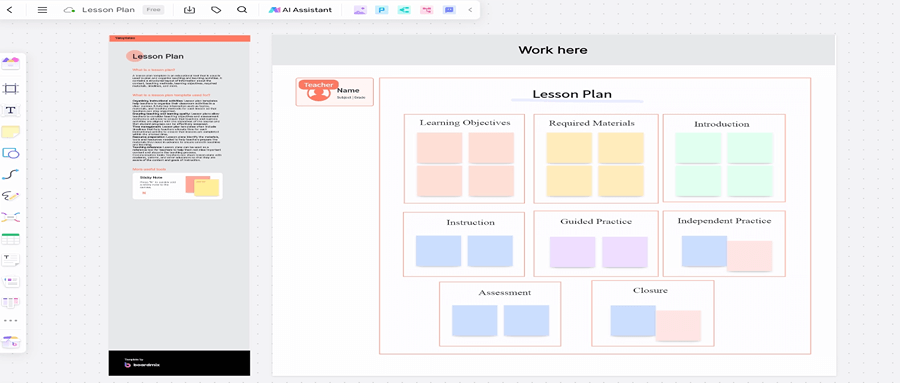
1. Learning Objectives
This is where you clearly define what students should know or be able to do by the end of the lesson. The objectives should be SMART: Specific, Measurable, Attainable, Relevant, and Time-bound.
2. Required Materials
List all the materials and resources you will need for the lesson. These might include textbooks, handouts, presentation slides, videos, audio clips, lab equipment, art supplies, etc.
3. Introduction
This is the beginning of your lesson where you engage students' interest and prepare them for learning. You can introduce the topic through a question, a brief discussion, a video clip, or an intriguing statement.
4. Instruction
Here, you provide direct instruction on the topic. You might give a lecture, show a demonstration, present a slideshow, or use another teaching method that best suits your content and audience.
5. Guided Practice
After instructing, guide your students as they practice the new skill or concept. This might involve completing exercises or activities as a class or in small groups.
6. Independent Practice
Allow students to practice independently what they have learned. This can involve assigning homework or classwork where they apply the new skills or concepts without your direct guidance.
7. Assessment
Outline how you plan to assess students' understanding of the lesson. This could be through quizzes, oral responses, classwork, homework, or projects.
8. Closure
Wrap up the lesson by summarizing the key points, answering any remaining questions, and previewing what will be covered in the next lesson.
9. Differentiation Strategies
Specify how you plan to differentiate instruction to meet the diverse needs of your students. This might involve providing additional support or challenges to certain students.
10. Reflection
After the lesson, reflect on its effectiveness. Consider what worked well, what didn't, and how you could improve it in the future.
Remember that a lesson plan is not a script that must be followed verbatim but rather a guide to ensure you are prepared for each class and can effectively facilitate student learning.
8 Practical Lesson Plan Examples
1. Lesson Plan for Teachers
This Lesson Plan for Teachers introduces 5th graders to renewable energy concepts through an engaging, hands-on project.
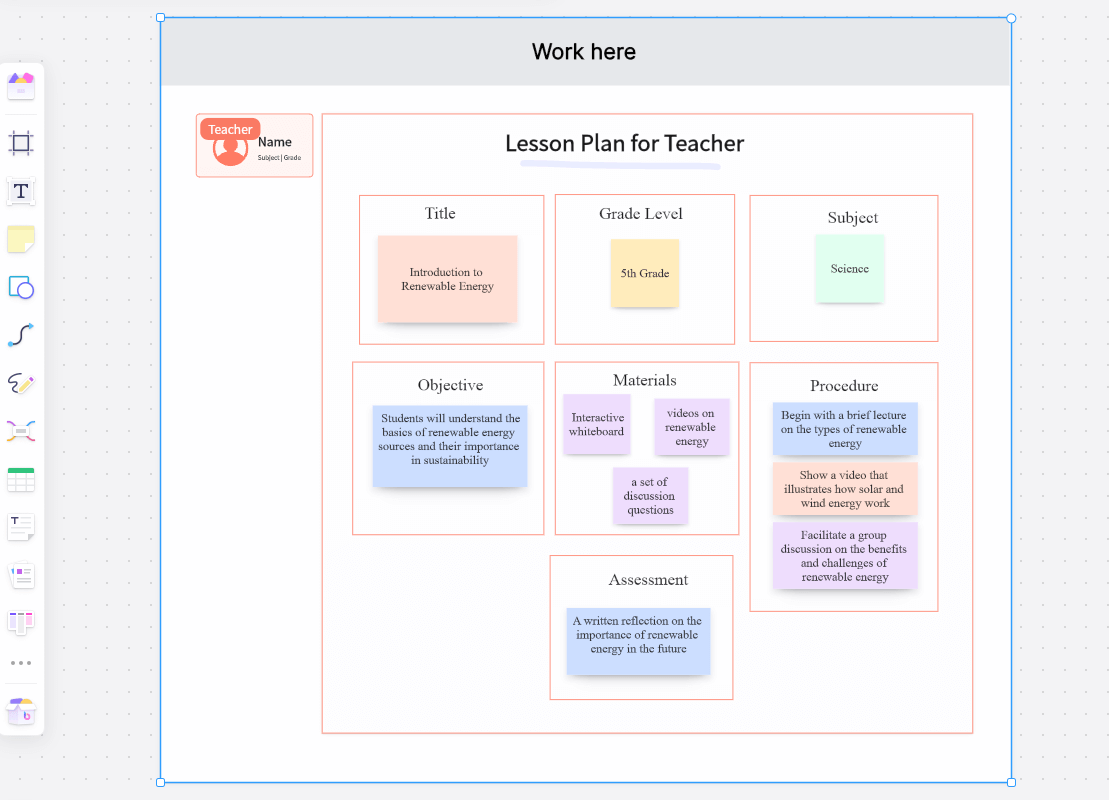
1. Title: Introduction to Renewable Energy
2. Grade Level:5th Grade
3. Subject: Science
4. Objective: Students will understand the basics of renewable energy sources and their importance in sustainability.
5. Materials: Interactive whiteboard, videos on renewable energy, and a set of discussion questions.
6. Procedure:
- Begin with a brief lecture on the types of renewable energy.
- Show a video that illustrates how solar and wind energy work.
- Facilitate a group discussion on the benefits and challenges of renewable energy.
- Assign a hands-on activity where students design their own renewable energy project.
7. Assessment: A written reflection on the importance of renewable energy in the future.
2. Lesson Plan for Preschool
This lesson plan takes preschoolers on a journey of discovery with colors and shapes through storytelling and artistic expression.
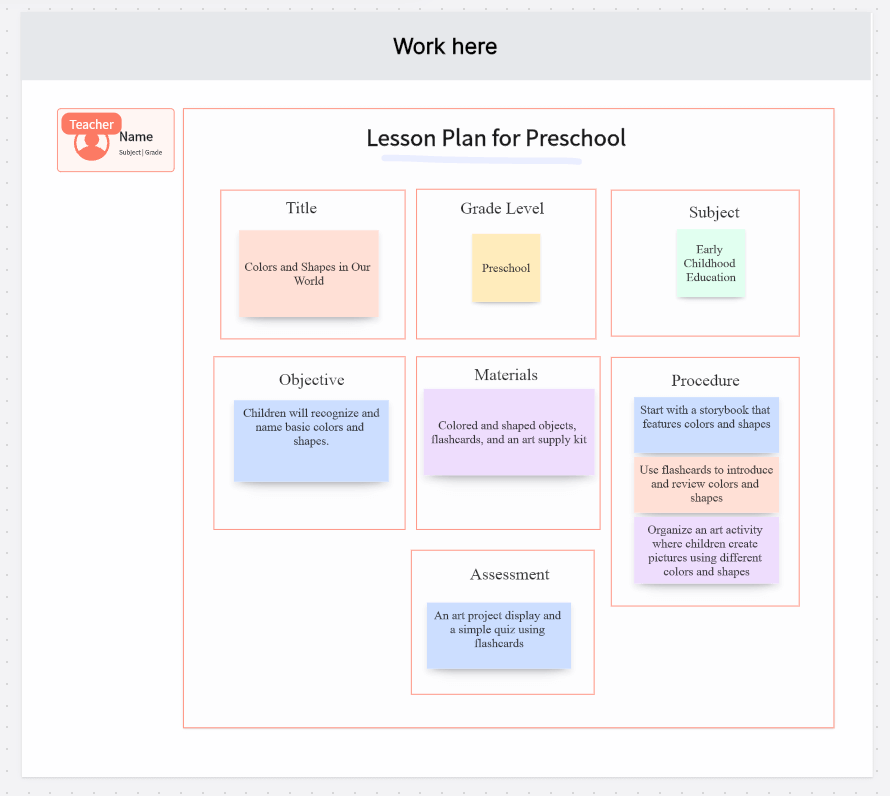
1. Title: Colors and Shapes in Our World
2. Grade Level:Preschool
3. Subject: Early Childhood Education
4. Objective: Children will recognize and name basic colors and shapes.
5. Materials: Colored and shaped objects, flashcards, and an art supply kit.
6. Procedure:
- Start with a storybook that features colors and shapes.
- Use flashcards to introduce and review colors and shapes.
- Organize an art activity where children create pictures using different colors and shapes.
- Conduct a class walk-through to identify colors and shapes in the classroom.
7. Assessment: An art project display and a simple quiz using flashcards.
3. Lesson Plan for Nursery
In the Lesson Plan for Nursery, Environmental Science is introduced to nursery-aged children through the care and observation of plants.
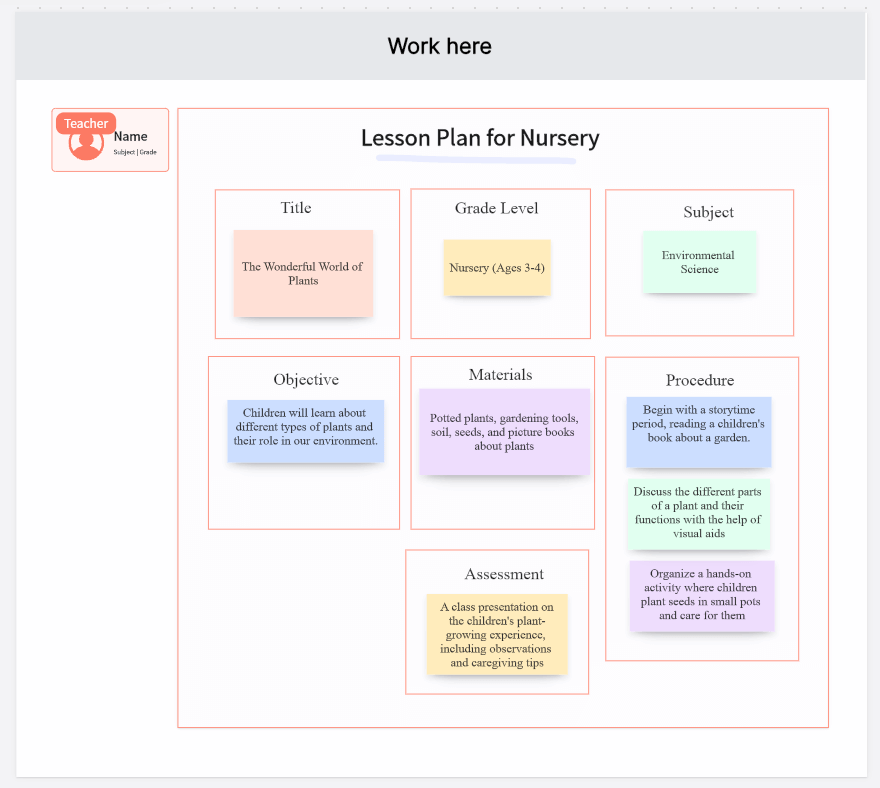
1. Title: The Wonderful World of Plants
2. Grade Level: Nursery (Ages 3-4)
3. Subject: Environmental Science
4. Objective: Children will learn about different types of plants and their role in our environment.
5. Materials: Potted plants, gardening tools, soil, seeds, and picture books about plants.
6. Procedure:
- Begin with a storytime period, reading a children's book about a garden.
- Discuss the different parts of a plant and their functions with the help of visual aids.
- Organize a hands-on activity where children plant seeds in small pots and care for them.
- Encourage observation and journaling of the plants' growth over time.
7. Assessment: A class presentation on the children's plant-growing experience, including observations and caregiving tips.
4. Lesson Plan for Infants
The Lesson Plan for Infants is designed for infants, focusing on stimulating cognitive development through sensory exploration of sounds and textures.
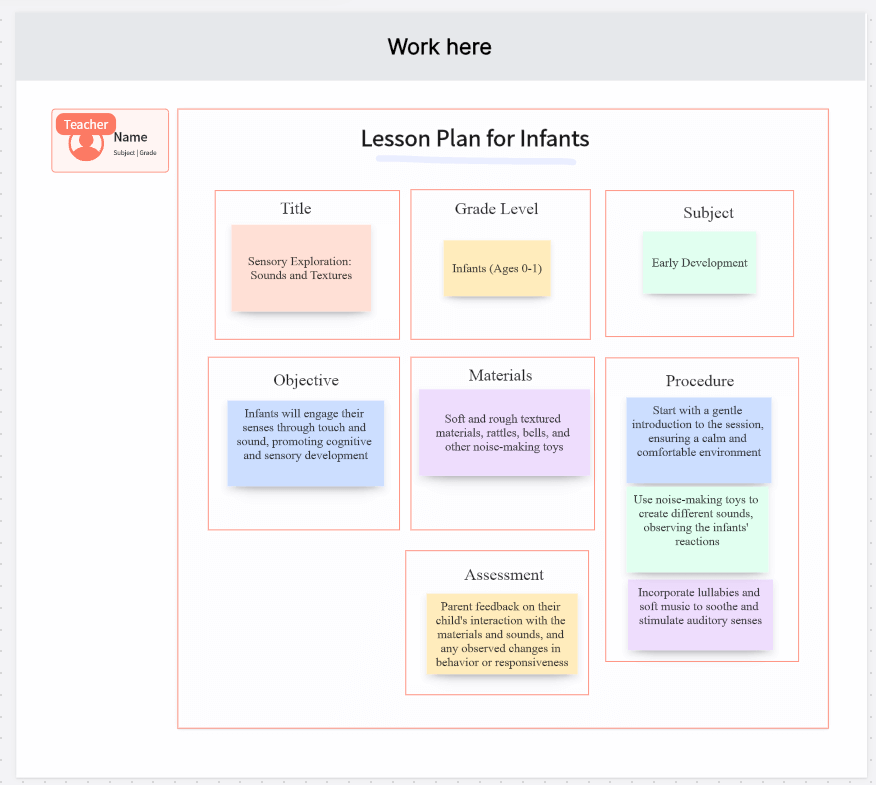
1. Title: Sensory Exploration: Sounds and Textures
2. Grade Level: Infants (Ages 0-1)
3. Subject: Early Development
4. Objective: Infants will engage their senses through touch and sound, promoting cognitive and sensory development.
5. Materials: Soft and rough textured materials, rattles, bells, and other noise-making toys.
6. Procedure:
- Start with a gentle introduction to the session, ensuring a calm and comfortable environment.
- Introduce various textured materials, encouraging infants to touch and feel them.
- Use noise-making toys to create different sounds, observing the infants' reactions.
- Incorporate lullabies and soft music to soothe and stimulate auditory senses.
7. Assessment: Parent feedback on their child's interaction with the materials and sounds, and any observed changes in behavior or responsiveness.
5. Lesson Plan for Maths
In the Lesson Plan for Maths for 3rd graders, the world of fractions becomes accessible and tangible through real-world applications and manipulatives.
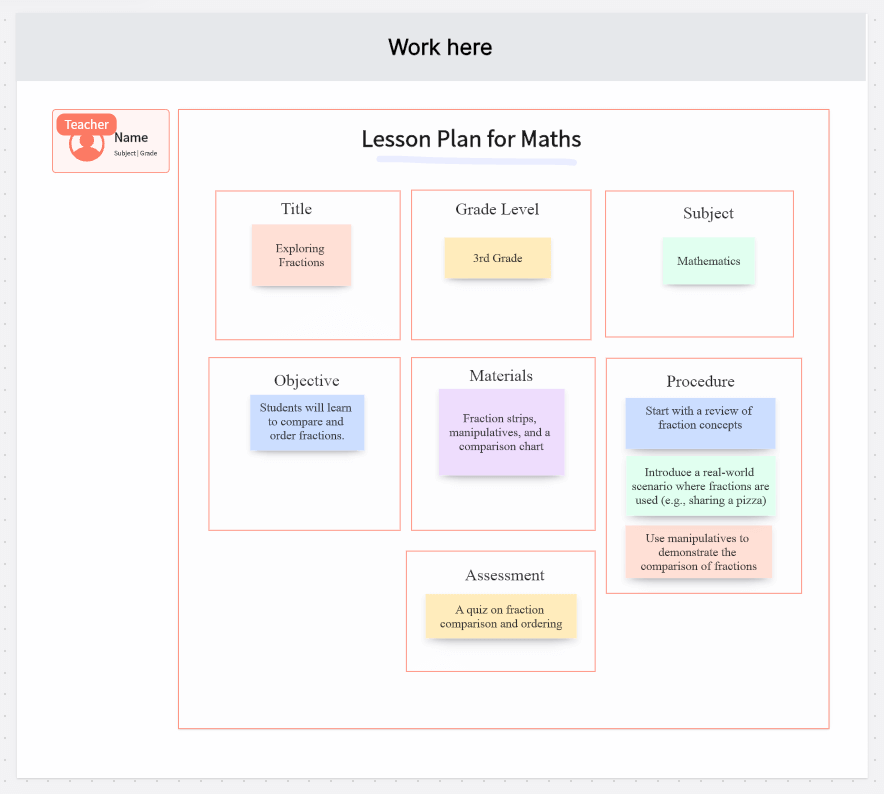
1. Title: Exploring Fractions
2. Grade Level:3rd Grade
3. Subject: Mathematics
4. Objective: Students will learn to compare and order fractions.
5. Materials: Fraction strips, manipulatives, and a comparison chart.
6. Procedure:
- Start with a review of fraction concepts.
- Introduce a real-world scenario where fractions are used (e.g., sharing a pizza).
- Use manipulatives to demonstrate the comparison of fractions.
- Conduct a class activity where students sort fractions using a chart.
7. Assessment: A quiz on fraction comparison and ordering.
6. Lesson Plan for Science
The Lesson Plan for Science is a 4th-grade exploration of the human skeleton brought to life with interactive games and creative poster projects.
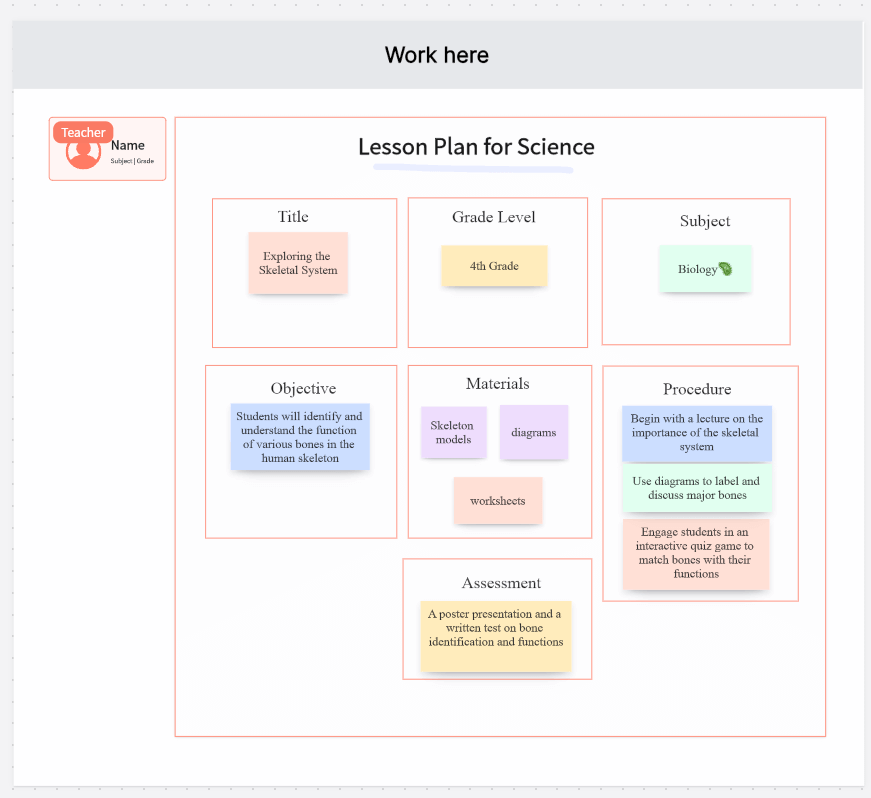
1. Title: The Human Body: Exploring the Skeletal System
2. Grade Level: 4th Grade
3. Subject: Biology
4. Objective: Students will identify and understand the function of various bones in the human skeleton.
5. Materials: Skeleton models, diagrams, and worksheets.
6. Procedure:
- Begin with a lecture on the importance of the skeletal system.
- Use diagrams to label and discuss major bones.
- Engage students in an interactive quiz game to match bones with their functions.
- Have students create a poster of the skeletal system, highlighting key bones.
7. Assessment: A poster presentation and a written test on bone identification and functions.
7. Madeline Hunter Lesson Plan
The Madeline Hunter Lesson Plan is a 2nd-grade lesson plan that deepens reading comprehension and analytical skills through a classic fable.
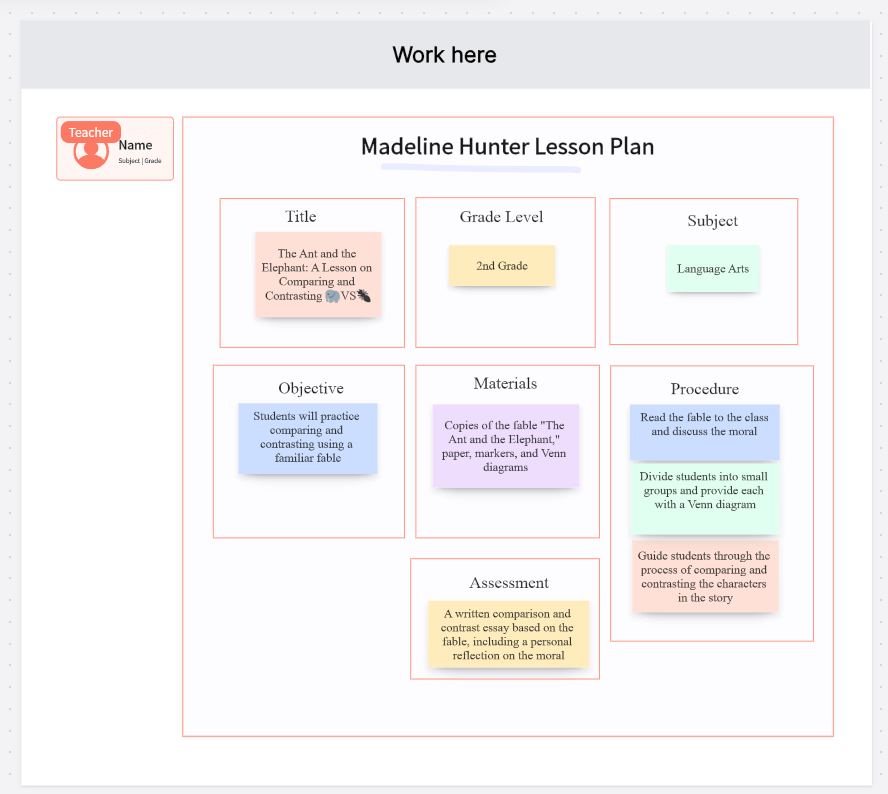
1. Title: The Ant and the Elephant: A Lesson on Comparing and Contrasting
2. Grade Level: 2nd Grade
3. Subject: Language Arts
4. Objective: Students will practice comparing and contrasting using a familiar fable.
5. Materials: Copies of the fable "The Ant and the Elephant," paper, markers, and Venn diagrams.
6. Procedure:
- Read the fable to the class and discuss the moral.
- Divide students into small groups and provide each with a Venn diagram.
- Guide students through the process of comparing and contrasting the characters in the story.
- Have each group present their findings to the class, highlighting key similarities and differences.
7. Assessment: A written comparison and contrast essay based on the fable, including a personal reflection on the moral.
8. Critical Race Theory Lesson Plan
The Critical Race Theory Lesson Plan offers 5th graders an exploration of diversity and inclusion through historical context and critical discussions.
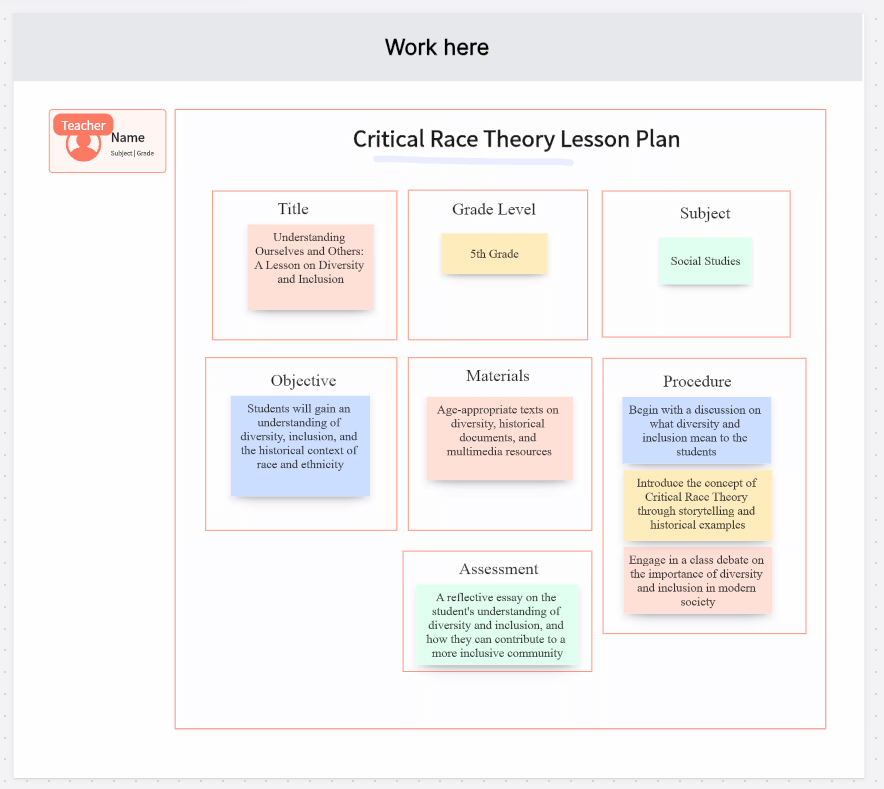
1. Title: Understanding Ourselves and Others: A Lesson on Diversity and Inclusion
2. Grade Level:5th Grade
3. Subject: Social Studies
4. Objective: Students will gain an understanding of diversity, inclusion, and the historical context of race and ethnicity.
5. Materials: Age-appropriate texts on diversity, historical documents, and multimedia resources.
6. Procedure:
- Begin with a discussion on what diversity and inclusion mean to the students.
- Introduce the concept of Critical Race Theory through storytelling and historical examples.
- Facilitate a guided inquiry where students research and present on a historical figure who contributed to diversity and inclusion.
- Engage in a class debate on the importance of diversity and inclusion in modern society.
7. Assessment: A reflective essay on the student's understanding of diversity and inclusion, and how they can contribute to a more inclusive community.
These additional lesson plan examples cover a range of topics and age groups, providing educators with a diverse toolkit for creating engaging and effective learning experiences. By incorporating these plans into their teaching repertoire, educators can ensure that they are meeting the varied needs of their students and fostering an environment of understanding, growth, and critical thinking.
Online Lesson Plan AI Generator & Tool
Planning lessons can be a time-consuming task for educators. With the vast curriculum that needs to be covered, it becomes necessary to create comprehensive and effective lesson plans to ensure learning objectives are met. Boardmix is an AI-powered tool to assist educators in creating efficient and effective lesson plans. This platform leverages artificial intelligence to analyze educational content and propose a structured lesson plan tailored to the educator's teaching goals and students' learning needs.
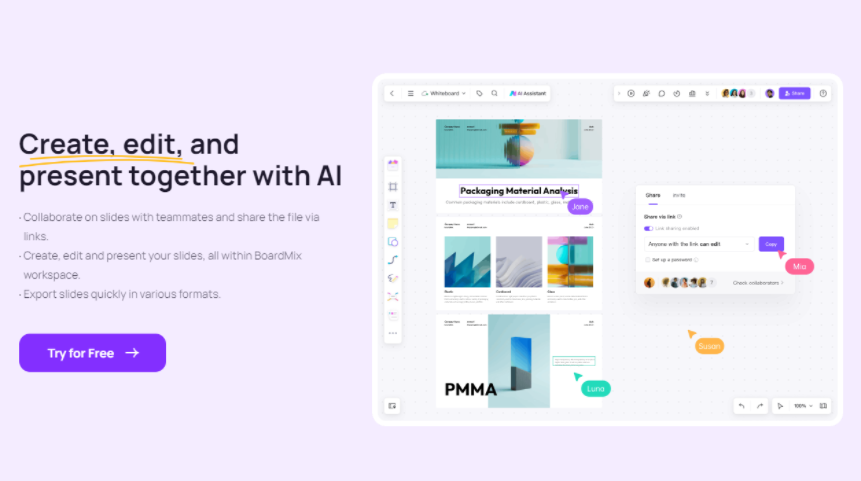
Features of Boardmix Lesson Plan AI Generator
Here are some notable features that set Boardmix apart as a lesson plan generator:
1. Automatic Lesson Structure
Based on the provided educational content, Boardmix generates a structured lesson plan, including the learning objectives, introduction, instruction, practice tasks, assessments, and closure. This automated process helps reduce planning time significantly.
2. Customizable Lesson Plans
While Boardmix provides a structured format, it also allows for customization. Teachers can adjust and modify the generated lesson plan according to their teaching style and students' learning preferences.
3. Content Suggestion
Boardmix's AI engine can suggest relevant educational content, activities, and assessment methods based on the learning objectives and teaching goals.
4. Standards Alignment
Boardmix aligns lesson plans with education standards, ensuring that all learning objectives meet the required benchmarks set by education authorities.
How to Use Boardmix Lesson Plan AI Generator
Here's a simple guide on how you can leverage Boardmix in creating lesson plans.
Step 1: Sign Up
Create an account on the Boardmix platform using your email address.

Step 2: Input Lesson Information
After logging in, provide necessary information about the lesson - subject, grade level, learning objectives, etc.
Step 3: Let AI Work Its Magic
Once you have filled in the necessary details, click on "Generate Lesson Plan." The AI will then process the information and create a structured lesson plan.
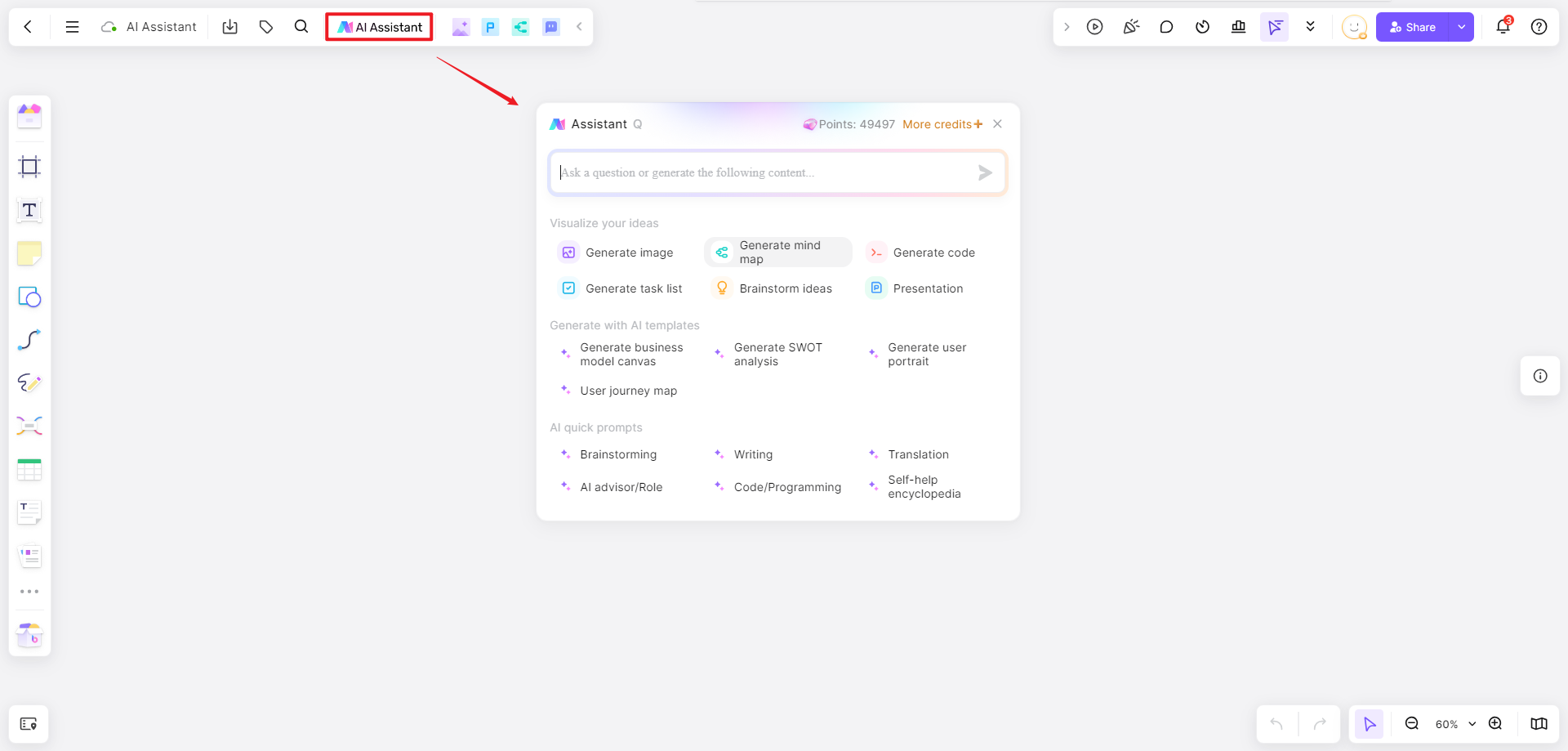
Step 4: Customize Your Lesson Plan
Review the generated plan, make adjustments if needed, and add any additional material or activities.
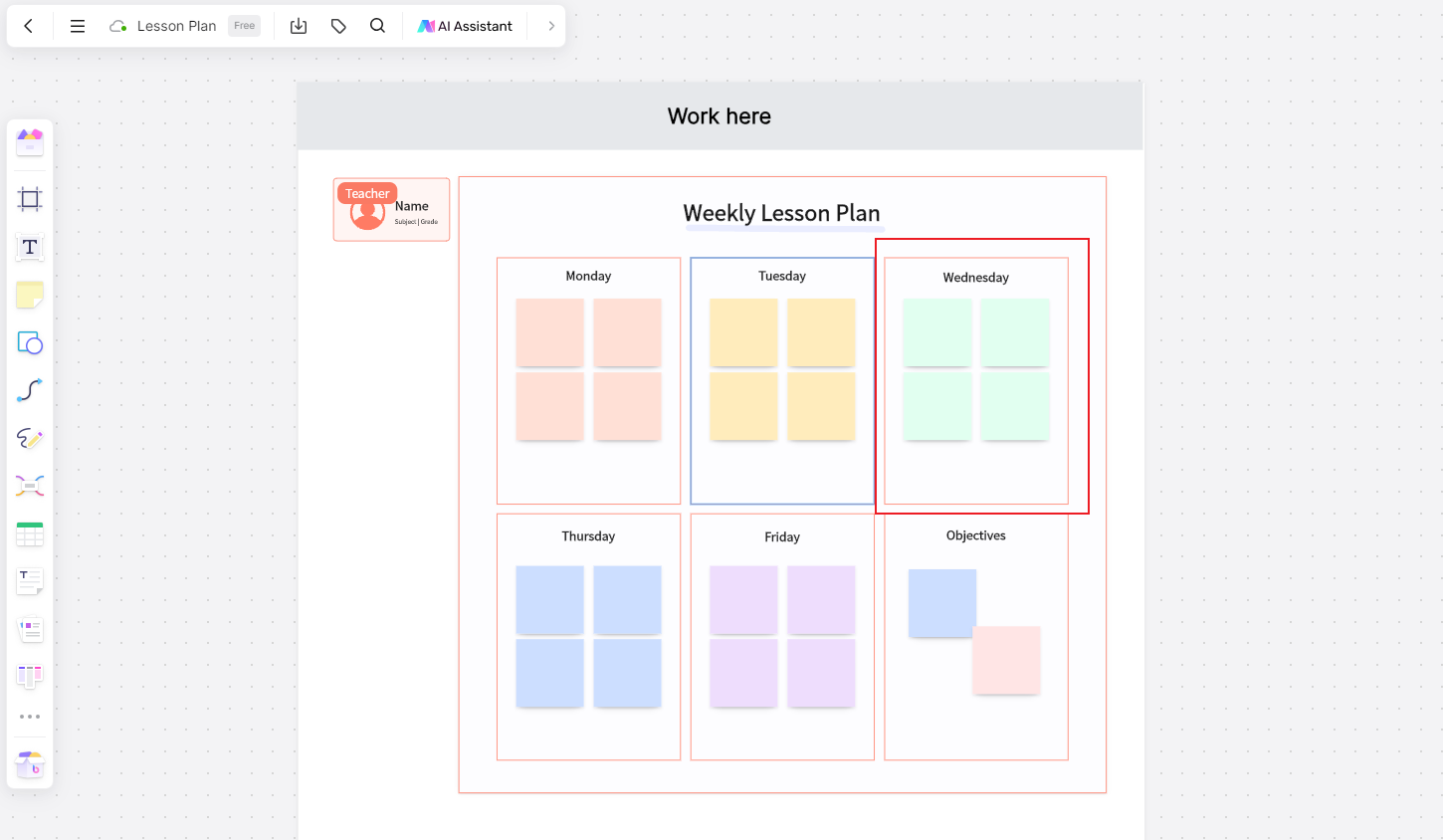
Step 5: Save and Share Your Lesson Plan
Finally, save your tailored lesson plan for future use or share it with fellow educators or students.
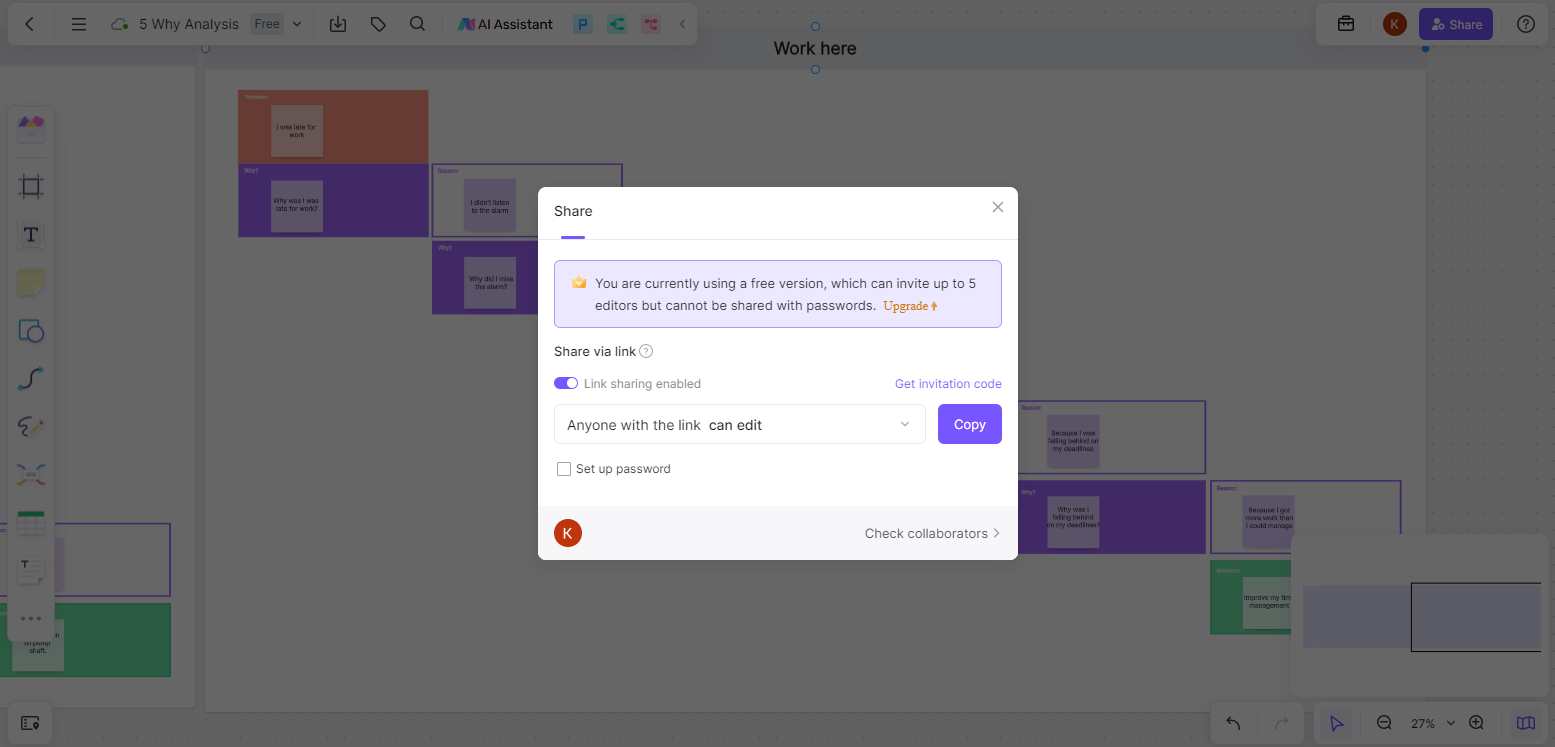
With Boardmix Lesson Plan AI Generator, lesson planning becomes a seamless process. It's like having your assistant that understands your needs and helps you create effective and engaging lesson plans.
Conclusion
In conclusion, effective lesson planning is the cornerstone of successful teaching. By leveraging practical examples and AI-powered tools like Boardmix, educators can create engaging and impactful lesson plans that cater to diverse learning environments and student needs. With these resources at your disposal, take your teaching to the next level and make your lesson planning a breeze.









